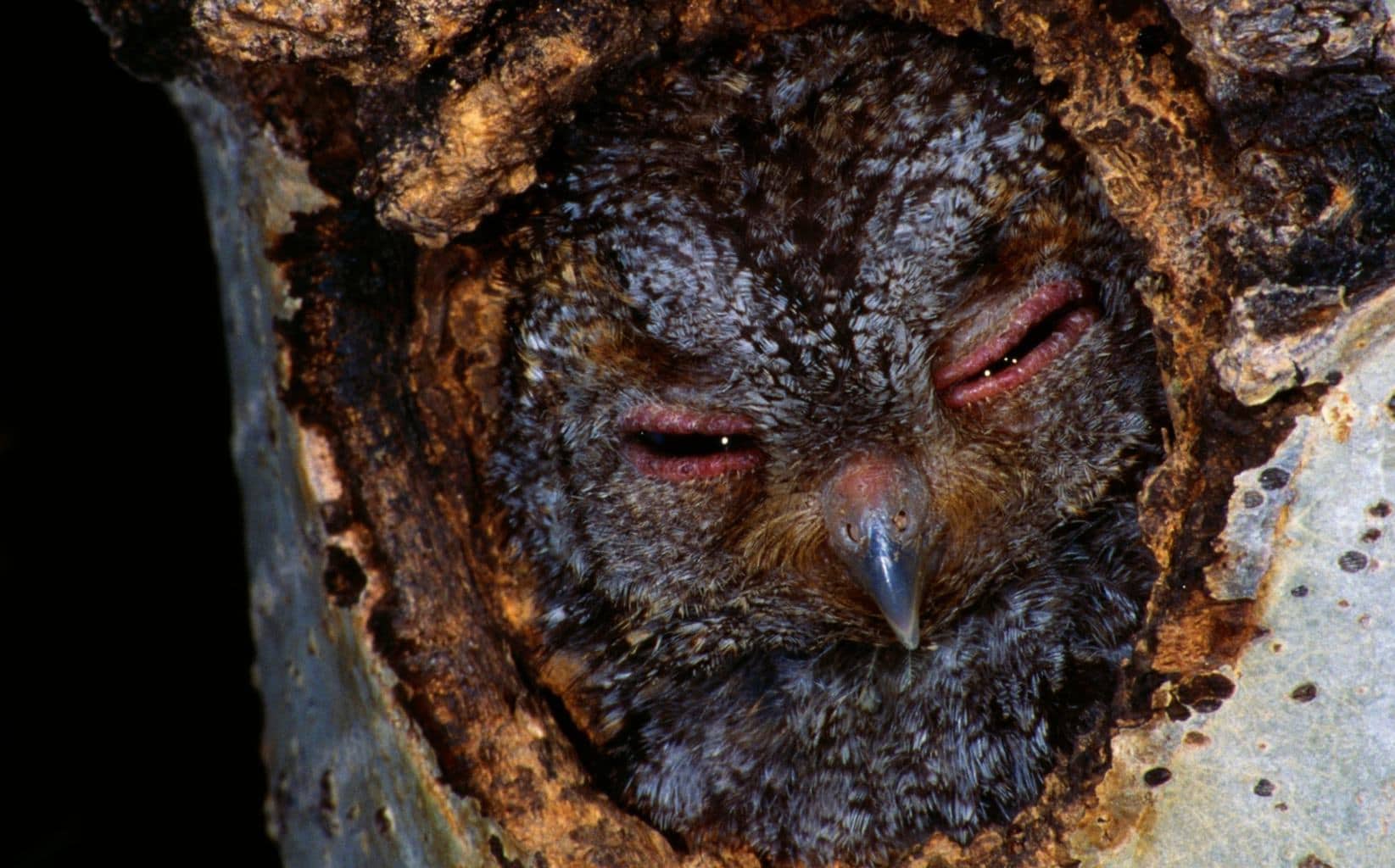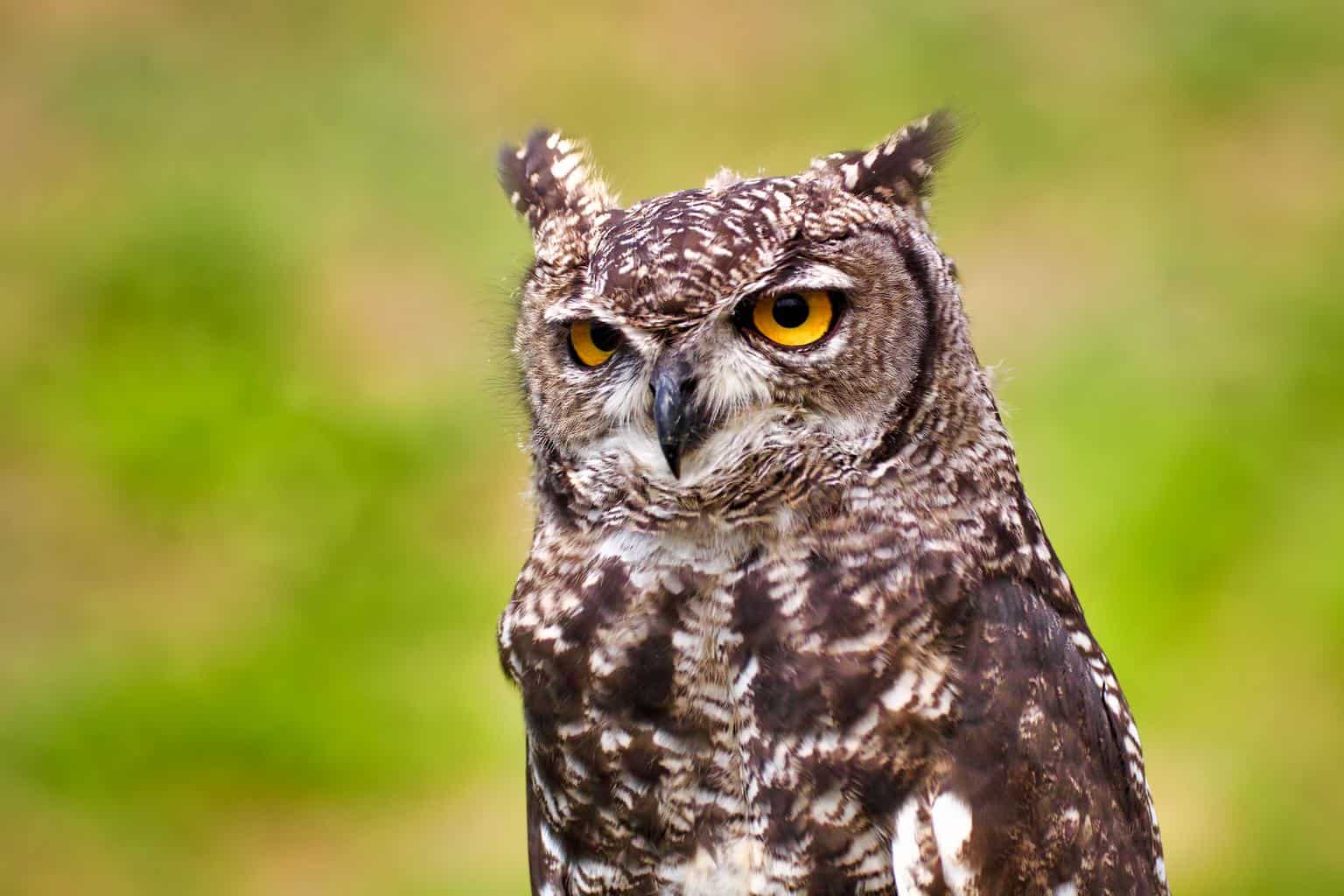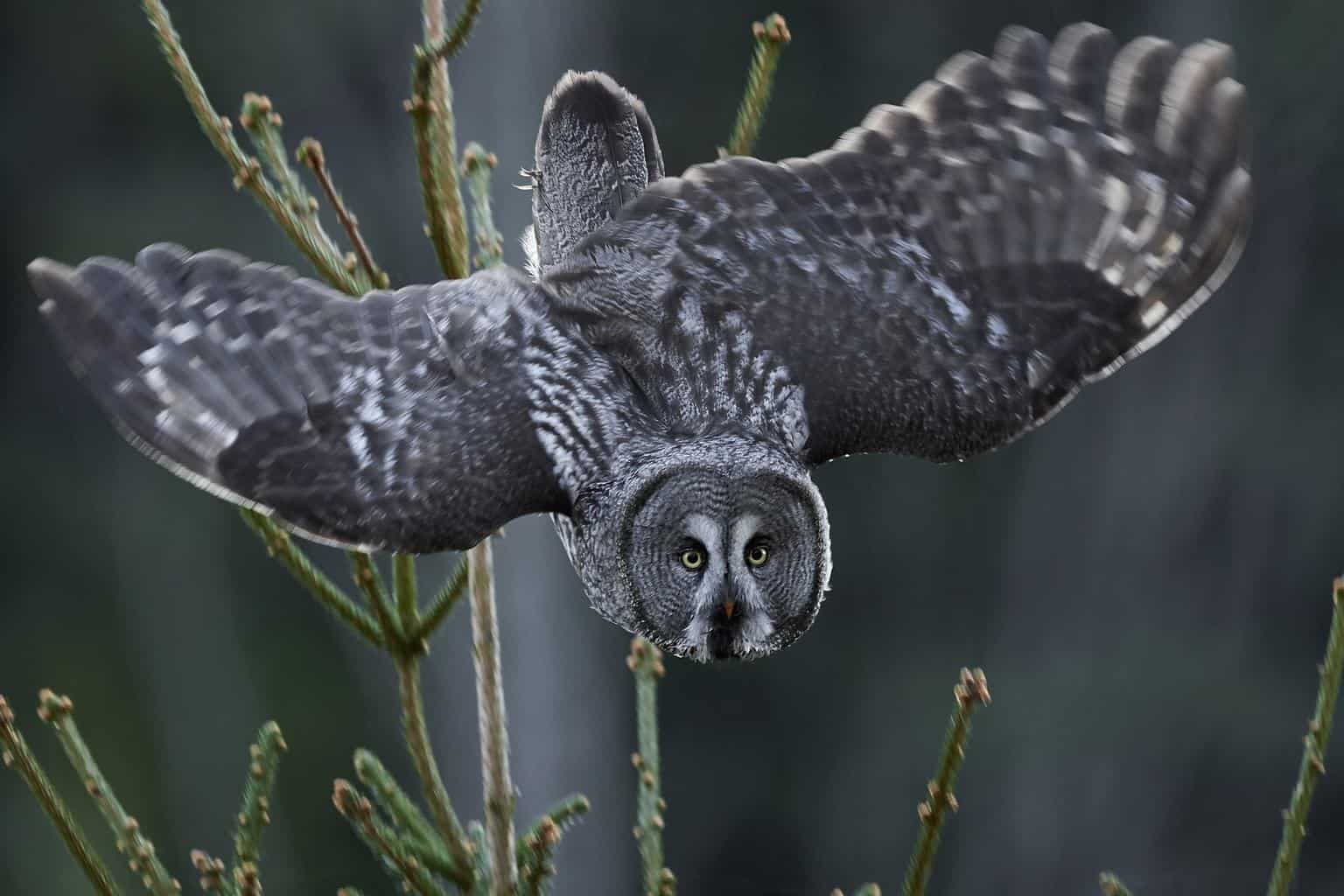South Dakota, also known as The Mount Rushmore State, is filled with stunning landscapes and wildlife. It shouldn’t come as a surprise that it’s often referred to as “the land of infinite variety.” Evenly divided up into four distinct geographical regions, the north-central state has a bit of everything! All this richness makes South Dakota the perfect home for a particular type of stealthy raptor: the owl!
We rounded up all 13 species of owls in South Dakota in this article. Whether you’re an avid birdwatcher or you just love owls, you’ve come to the right place.
Below, you’ll find everything you’ve ever wanted to learn about these enigmatic predators.
Eastern Screech-Owl

- Scientific Name: Megascops asio
- Length: 6 – 10 in
- Weight: 4 – 9 oz
- Wingspan: 19 – 24 in
The Eastern Screech-Owl is known for its stocky appearance. It’s mostly reddish-brown or gray, mixed in with brown spots and stripes, which helps it blend in perfectly with its surroundings.
These nocturnal raptors can be identified more by their trills than by what they look like. If you happen to spot one, it’ll most likely be somewhere with plenty of trees, especially if it’s near water.
Eastern Screech-Owls are opportunistic hunters. They eat whatever comes their way without making a big fuss.
Snowy Owl

- Scientific Name: Bubo scandiacus
- Length: 20.5 – 28 in
- Weight: 56 – 104 oz
- Wingspan: 50 – 57 in
Snowy Owls are large, beautiful birds with rounded heads, no tufts, and legs covered with thick, white feathers.
You can spot these diurnal raptors in wide-open fields. They also like flying close to the ground, where it’s easier for them to find food. Snowy Owls are patient hunters. Their diet consists of rodents, squirrels, and other small mammals.
During the summer, Snowy Owls migrate to the north for their breeding season. Then, when winter comes around, they return to South Dakota and other warmer states.
Flammulated Owl

- Scientific Name: Psiloscops flammeolus
- Length: 6 – 7 in
- Weight: 1.5 – 2 oz
- Wingspan: 16 – 16.5 in
Flammulated Owls can be difficult to spot, even during the day. They’re small and covered in brown, rust, gray, and white.
Their large windpipes make their hoots sound more low-pitched, which gives the impression they’re much larger than they actually are.
Typically, these nocturnal raptors find shelter in old coniferous forests. The thick branches help keep them well-hidden and out of sight.
Because of their small size, Flammulated Owls prefer hunting insects. They mostly eat moths, crickets, grasshoppers, and beetles.
Burrowing Owl

- Scientific Name: Athene cunicularia
- Length: 7.5 – 10 in
- Weight: 5.3 – 6 oz
- Wingspan: 21 – 23 in
The Burrowing Owl has a round head and a short tail. Their long legs make foraging on the ground easier. Their heads, back, and underwings are tan-colored. Their chests have white and brown spots.
As their name suggests, these diurnal raptors live underground in burrows. They usually take over existing burrows and claim them as their own.
You can find these migratory birds in many regions across South Dakota in areas where they can find the most prey, including rodents and insects.
Great Horned Owl

- Scientific Name: Bubo virginianus
- Length: 17 – 25 in
- Weight: 40 – 64 oz
- Wingspan: 40 – 57 in
Great Horned Owls have one of the largest wingspans of any owl species. Their broad wings have rounded tips that help them launch into silent flight.
These ferocious predators are nocturnal. You may see them at dusk flying across open fields or perching on a fence post.
Being large and bulky, they need lots of energy for sustenance. They hunt large prey, such as other raptors, geese, and large birds. They also snack on small prey as well, including frogs, mice, and insects.
Barred Owl

- Scientific Name: Strix varia
- Length: 17 – 20 in
- Weight: 17 – 37 oz
- Wingspan: 39 – 43 in
Barred Owls have no ear-like tufts. Their wings and tails are more rounded compared to other owl species. The Barred Owl is known for its vertical brown bars on its underwings. The rest of its body is mottled brown and white.
While they’re mainly nocturnal, you can sometimes hear Barred Owls hooting during the day. They prefer mature evergreen or deciduous forests, preferably near water.
Barred Owls hunt small birds and rodents. They also like snacking on insects and invertebrates.
Great Gray Owl

- Scientific Name: Strix nebulosa
- Length: 24 – 33 in
- Weight: 25 – 60 oz
- Wingspan: 54 – 60 in
The Great Gray Owl gets its name from its coloring and its intimidating size. But, these raptors aren’t bulky because of extra weight. They’re covered in thick feathers that make them look heavy.
These nocturnal predators search for food by flying low over open fields. Yet, they prefer roosting in dense forests.
They’re non-migratory, which means you can spot them year-round. Their favorite place to perch is on a tree branch waiting for their next meal.
Boreal Owl

- Scientific Name: Aegolius funereus
- Length: 8 – 11 in
- Weight: 3 – 8 oz
- Wingspan: 22 – 24 in
Boreal Owls are mainly brown with dots scattered over their body and crown. Their bellies have brown and black markings.
Hunting at night, Boreal Owls are the sit-and-wait type. They’re also not picky when it comes to their habitat. You can spot them perching on branches about 20 feet above the ground. They roost in a different tree each day, preferring to stay close to the trunk.
They’re not known to migrate. If they do, it’s usually because there’s a food shortage.
American Barn Owl

- Scientific Name: Tyto furcata
- Length: 13 – 16 in
- Weight: 14 – 25 oz
- Wingspan: 40 – 29 in
Almost all Barn Owls are known for their white, heart-shaped faces. They have no ear tufts, which makes their heads appear round.
Barn Owls are nocturnal predators. They prefer nesting in quiet, out-of-the-way cavities and old, abandoned barns. They hunt by flying back and forth over open fields. In fact, their looping flying style is unique and distinctive to the Barn Owl.
Since Barn Owls are non-migratory, you can spot them year-round in various areas across South Dakota.
Northern Saw-Whet Owl

- Scientific Name: Aegolius acadicus
- Length: 6.5 – 9 in
- Weight: 2 – 5 oz
- Wingspan: 16.5 – 22 in
The Northern Saw-whet Owl ranges in color from tans to pale browns. Their bodies are mottled with pale spots and stripes.
When searching for a habitat, these nocturnal raptors prefer mixed hardwood forests. They also prefer being near water. They’re migratory and usually take over abandoned woodpecker holes, as long as they’re within dense vegetation. Plus, they sometimes use them as nesting boxes.
Northern Saw-whets prefer hunting small rodents but will eat insects and invertebrates as well.
Short-Eared Owl

- Scientific Name: Asio flammeus
- Length: 13 – 17 in
- Weight: 7 – 17 oz
- Wingspan: 33.5 – 40.5 in
Short-eared Owls have broad wings and short tails. They have short ear tufts that appear only when they’re communicating with other owls. You can spot these medium-sized raptors by their black and dark brown plumage. Their underwings and chest area are a bit paler.
Their habitat includes open areas and grasslands. You can spot them perching in low trees and even on the ground.
These diurnals fly close to the ground over short vegetation in search of food.
Long-Eared Owl

- Scientific Name: Asio otus
- Length: 14 – 16 in
- Weight: 8 – 15 oz
- Wingspan: 35 – 39 in
Long-eared Owls have slender bodies and round tails. They’re black with brown and gray markings on their bodies, which help them blend in with their surroundings.
They prefer nesting in heavily wooded areas where they can stay safely hidden. These raptors are one of the few that roost as a group, and they even share their nests with fellow Long-ears.
When foraging, these nocturnal predators head to open grasslands. They like flying close to the ground looking for voles and other rodents.
Northern Hawk Owl

- Scientific Name: Aegolius acadicus
- Length: 14 – 18 in
- Weight: 8.5 – 16 oz
- Wingspan: 28 – 30 in
Even though the Northern Hawk Owl behaves like a hawk, it looks more like an owl. As with most owl species, this one has an oval body and a round face. It’s mostly dark brown, with a pale spotting pattern on the back.
Their hawk-like behavior is shown through their preference to perch on solitary trees. They also tend to avoid dense forests, which is another feature they share with hawks.
When hunting, they scan for rodents and small mammals from their perch. Then, at the right moment, they glide down and snatch them with their talons.
Conclusion
So, what do you think of our roundup of all 13 owls in South Dakota? We can’t get enough of these fascinating raptors. Just watching them take flight and soar overhead is breathtaking!
What’s even more exciting is that almost all of them are year-round residents of the state. This means you can appreciate them in their natural habitat anytime you like.
Better still, why not invite them over to your backyard feeder for an afternoon snack?
If you’re interested in learning about other bird species in South Dakota, then you should check out the states’ 12 species of woodpeckers. These hard-working birds will keep you mesmerized for hours.

